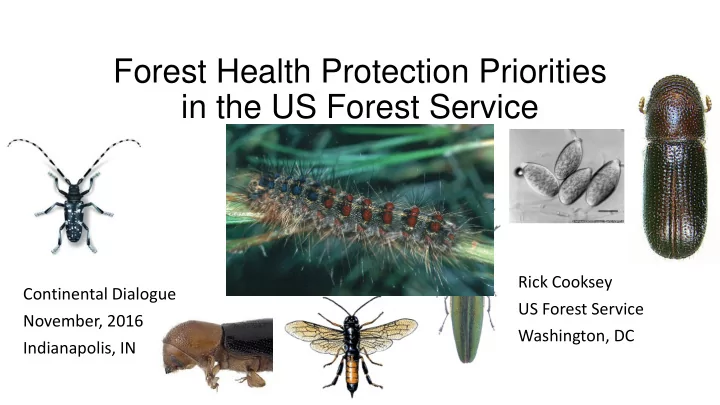

Forest Health Protection Priorities in the US Forest Service Rick Cooksey Continental Dialogue US Forest Service November, 2016 Washington, DC Indianapolis, IN
Forest Health Protection Outline -> Forest Service -> Fire -> FHP Program -> Updates -> Done • 250 Forest Health Professionals • Work with States and other stakeholders across all 50 states, including Puerto Rico • Conduct surveys for forest insects, pathogens and plants • Together, we deal with insects, diseases, and invasive plants and their impact to the urban and forested landscapes • We assess risk of infestations, detect threats, and respond with technical and financial assistance • Develop and apply cutting edge technologies and tools to assess and manage for forest health
America’s Forests 2013 – 2027 National Forest Risk Assessment
Forest Health Mortality - 2015 4.7 million acres
Forest Health Protection, 2004-2016 $25,000,000 $20,000,000 $15,000,000 $10,000,000 $5,000,000 $0 FY 2004 FY 2005 FY 2006 FY 2007 FY 2008 FY 2009 FY 2010 FY 2011 FY 2012 FY 2013 FY 2014 FY 2015 FY 2016 Western Bark Beetles Southern Pine Beetle Hemlock Woolly Adelgid Gypsy Moth Total
Forest Health Protection Increasing list of funding needs Pre 1990’s: Gypsy moth Western bark beetles Southern pine beetle 1990’s: Asian longhorned beetle Hemlock woolly adelgid Sudden oak death 2000’s: Emerald ash borer Laurel wilt Thousand cankers disease Gold-spotted oak borer Sirex wood wasp Winter moth Shot-hole borers Coconut rhinoceros beetle Rapid ohia death ...
Emerald Ash Borer Non-native beetle from Asia, first found in Michigan in 2002 It has quickly spread to 28 states, and killed tens of millions of trees The Forest Service has assisted APHIS and states in developing tools to help detect and manage infestations This is perhaps the most challenging and damaging pest we are dealing with The Forest Service has provided technical assistance to states to help communities manage infestations
Hemlock Woolly Adelgid Non-native, aphid-like insect from Japan. In the US since 1950’s Causes needle drying and discoloration, then eventual tree mortality Has impacted the ecological function of hemlocks, an important stream-side species Forest Service and state partners have released hundreds of thousands of biocontrol agents to help control the adelgid
Ambrosia Beetle les • Two complexes of non-native ambrosia beetles and their associated fungi are causing significant impacts; one in the southeastern US and one in California. • The redbay ambrosia beetle and the fungus that causes laurel wilt is found from North Carolina to Texas, and have impacted Lauraceae hosts including red bay, sassafras Red bay ambrosia beetle and avocado. • In California, two species of shothole borer ( Euwallacea spp.) and a Fusarium fungus have killed many species of trees in the Los Angeles and San Diego areas. • FHP staff have visited the native range of the shothole borer in China and Vietnam to look at its biology, flight period and test lures. • FHP staff also participated in a meeting in Mexico on identification, biology, impacts Polyphagous shothole borer and management of these ambrosia beetle species. 9
Shothole borer hosts in California 1. Box Elder ( Acer negundo ) 2. Castor bean ( Ricinus communis ) 3. Coast live oak ( Quercus agrifolia ) 4. Avocado (Persea americana ) 5. California sycamore ( Platanus racemosa ) 6. Big leaf maple ( Acer macrophyllum ) 7. English oak ( Quercus robur ) 8. Silk tree ( Albizia julibrissin ) 9. Coral tree ( Erythrina corallodendron ) 10.Chinese holly ( Ilex cornuta ) 11.Japanese maple ( Acer palmatum ) 12.Black bean ( Castanospermum australe ) 13.Palo verde ( Parkinsonia aculeata ) 14.Blue palo verde ( Cercidium floridium ) 15.Liquidambar ( Liquidambar styraciflua ) 16.Red Willow ( Salix laevigata ) 17.Weeping willow ( Salix babylonica ) 18.Trident maple ( Acer nuergerianum ) 19.Tortusa ( Salix matsudana ) 10
Southern Pine Beetle Native insect, historically found from Maryland south to Texas and Florida Infestations have recently been found in New Jersey, New York and Connecticut Infestations quickly kill large areas of mature, dense pine forests Forest Service and state partners have preventatively thinned more than 1 million acres to improve tree health and make forests more resistant to beetle attacks
White Pine Blister Rust Invasive introduced into North America 1898 & 1910. High elevation whitebark pines are increasingly being impacted by this fungus in addition to damage from mountain pine beetle and stress of long-term drought. Forest Service is screening five-needle pines for WPBR resistance for restoration to these fragile ecosystems. Through our Genetic Conservation program and working with our partners, High Elevation Pine may yet be preserved.
Gypsy Moth Non-native insect introduced into Massachusetts in 1869 Caterpillars defoliate oaks and many other hardwoods eventually causing tree mortality Forest Service, APHIS and states work to suppress infestations in infested areas, eradicate infestations in the uninfested area, and slow- the-spread along the 1,000 mile advancing front.
Bark Beetles in the West There are several species of bark beetles in the west that impact forests The mountain pine beetle, spruce beetle and Douglas-fir beetle have had the most significant impact in the past few decades Infestations of these native beetles killed nearly 50 million acres since 2000 Forest Service strategy is to protect human safety in areas with hazardous trees, and reduce fire risk in high value areas.
What is Being Done? • Annual Survey and Monitoring • Technical and Financial Assistance to States & Private lands, Tribal, and other federal lands • Treatments on the Land – Working across boundaries to treat National Forest, State and Private lands
How Do We See the Future of Forest Health? • There will be challenges - Projections point to continued and increasing acres impacted by insects and disease • New agents are likely to create impacts in cities and our rural forests • The work of FHP is a rapid link between science and sound management decisions • The work of FHP matters - The on-the-ground science leads to avoided economic and environmental costs.
Recommend
More recommend